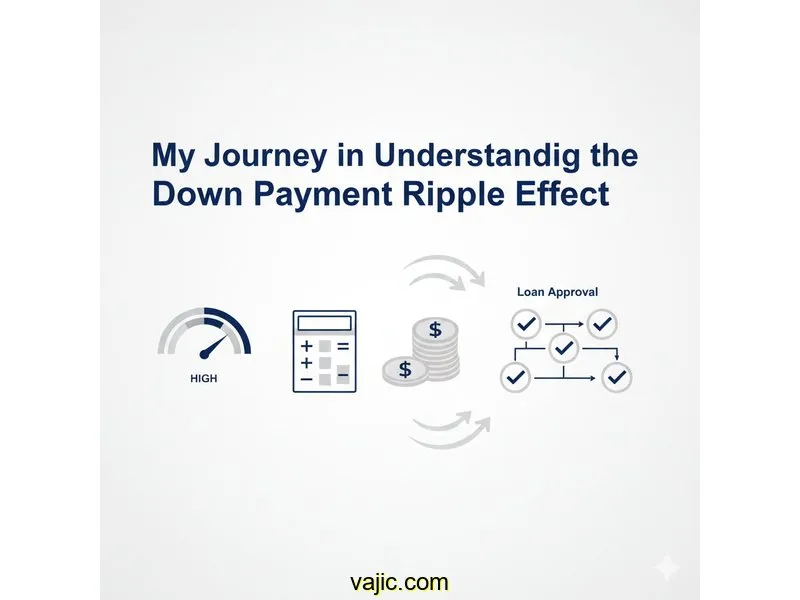
Auto Loan Calculator
Calculate payments over the life of your Loan
Home Blog Privacy Terms About Contact
Calculate payments over the life of your Loan
Home Blog Privacy Terms About ContactPublished on October 14, 2025

It all started with a daydream. I was scrolling through listings for used camper vans, and one caught my eye: a well-maintained van listed for $23,500. The idea was exciting, but the numbers were intimidating. My immediate focus went to the down payment. How much should I, theoretically, put down? My first thought was purely about the monthly payment. A bigger down payment means a smaller loan, which means a smaller monthly bill. Simple, right?
But then a more complex question started to form in my mind. Was that it? Was the down payment just a simple lever to make the monthly cost more manageable? Or did it do something more profound to the very structure of the loan? I wondered if a larger down payment had a kind of ripple effect, changing not just one number, but everything that came after it. How could I actually see and measure that effect?
This wasn't about deciding whether to buy the van. It was about a sudden, intense curiosity to understand the math. I grabbed my laptop and opened up a few online loan calculators, determined to see the numbers in action. I wanted to move beyond the surface-level understanding and really grasp the mechanics. This article is the story of that exploration. It’s about my personal journey to understand how calculations work, not a guide on what financial decisions to make.
My goal was simple: to use online tools to visualize how changing one single number—the down payment—could send waves through the entire loan calculation. What I discovered was far more interesting than I ever expected. It was a lesson in how interconnected all the pieces of a loan really are.

My first attempt at understanding this was, admittedly, very naive. I decided to compare two hypothetical scenarios for the $23,500 camper van. For both, I assumed a 60-month (5-year) loan term and found a representative interest rate of 7.8% to use for my educational exercise.
Scenario A: A small down payment of $2,500. This meant the loan amount would be $21,000.
Scenario B: A much larger down payment of $7,500. This meant the loan amount would be $16,000.
Here’s where my brain got stuck. The difference in down payments was $5,000 ($7,500 - $2,500). In my head, I figured the total savings would also be around $5,000. It seemed logical. I was borrowing $5,000 less, so I should pay back $5,000 less. I wasn't really thinking about the interest yet; I was just focused on the principal reduction.
I plugged the numbers for Scenario A ($21,000 loan, 7.8% rate, 60 months) into an online calculator. It spat out a monthly payment of about $423.70 and a total interest paid of $4,422.08. Okay, that seemed straightforward.
Then I plugged in Scenario B ($16,000 loan, 7.8% rate, 60 months). The monthly payment was, as expected, lower at about $322.82. But then I looked at the total interest paid. The calculator showed it was $3,369.21. I did the math on the interest savings: $4,422.08 - $3,369.21 = $1,052.87. This was my moment of complete confusion. I had put an extra $5,000 down, and my total repayment was not just $5,000 less, but $6,052.87 less ($5,000 less in principal plus $1,052.87 less in interest). Where did that extra $1,052.87 in savings come from?
My simple, linear thinking had failed me. I stared at the screen, trying to figure out the connection. It wasn't just about borrowing less money. The down payment was actively preventing interest from ever being created. I realized I didn't understand the fundamental calculation at all. I was seeing the result, but I couldn't explain the process. That's when my casual exploration turned into a deep dive to really understand the mechanics at play.
The frustration of not understanding that extra $1,052.87 was the push I needed. I decided to stop just plugging in numbers and start truly analyzing what the calculators were showing me. My goal was to build a mental model of how a down payment works *beyond* the initial subtraction. I had to understand its role over the entire life of the loan.
I set up a more controlled experiment. I used the same calculator and kept the item price ($23,500), interest rate (7.8%), and term (60 months) locked in. The only variable I changed was the down payment. I started with a small amount and slowly increased it, watching what happened to the 'Monthly Payment', 'Total Principal Paid', and most importantly, the 'Total Interest Paid' fields. I realized that the 'Total Interest Paid' field was the key. It was the number that revealed the true cost of borrowing, and it was the number most sensitive to the initial down payment.
The real "aha!" moment came when I stopped thinking about the down payment as a single event. Instead, I started seeing it as something that reshapes the entire 60-month journey of the loan. With a $21,000 loan, the first month's interest calculation is based on that full amount. But with a $16,000 loan, the very first interest charge is calculated on a much smaller number. This advantage compounds month after month.
This is where I finally used the "Show Amortization Schedule" feature on the calculator. I opened two schedules side-by-side: one for the $21,000 loan and one for the $16,000 loan. The difference was stunning. In month one for the $21,000 loan, about $136.50 went to interest. For the $16,000 loan, only about $104.00 went to interest. That difference of over $32 in the very first month, repeated and decreasing over 60 months, was where my "missing" $1,052.87 was hiding.
To be sure I truly understood, I ran a third scenario. What if I put down $11,750 (half the price)? The loan amount would be $11,750. The calculator showed a total interest paid of $2,474.34 over 60 months. Compared to my first scenario ($4,422.08 in interest), this was a massive difference. I could now confidently explain exactly why. The starting principal was so much lower that the total volume of interest ever generated was dramatically reduced. I had cracked my own code.
This deep dive into down payments taught me so much more than I expected about how loan math works. It was like learning the grammar of a new language. Before, I could read the words (the numbers), but now I can understand the sentences they form. Here are the most important lessons I took away about the calculations themselves.
During my learning process, a few key questions came up over and over. Here are the questions I taught myself to answer, focusing strictly on how the calculations and tools work.
An amortization schedule shows how each payment is split between principal and interest. A larger down payment lowers your starting principal. Since monthly interest is calculated on the current principal balance, a lower starting principal means less interest is accrued in the first month, and every month thereafter. This means a larger portion of your very first payment goes toward reducing the principal even further, creating a positive feedback loop that reduces total interest over the life of the loan.
The 'Monthly Payment' only shows affordability on a month-to-month basis. The 'Total Interest Paid' shows the complete cost of borrowing money over the entire term. Two loan options could have similar monthly payments (for example, by extending the term), but vastly different total interest costs. Focusing on total interest gives you a clearer picture of the loan's overall financial impact.
Absolutely. This is a great way to learn. You can set up a scenario with a specific down payment (e.g., $5,000) and then run the calculation for a 48-month term, a 60-month term, and a 72-month term. You will see how the down payment's impact on total interest changes as the term length changes, teaching you about the relationship between time and interest costs.
The key is to create a controlled experiment. Use the same total purchase price, interest rate, and loan term for both calculations. The only number you should change between the two scenarios is the down payment amount. This isolates the variable and ensures that any differences you see in the results (like monthly payment and total interest) are due *only* to the change in the down payment.
My journey that started with a simple question about a camper van ended up being a profound lesson in financial literacy. The biggest takeaway for me was realizing that a loan is not a single, scary number. It's a system of interconnected parts, and understanding how one part affects all the others is incredibly empowering.
Seeing that extra $5,000 down payment wipe out over $1,000 in future interest charges was a lightbulb moment. It wasn't magic; it was math. It was the predictable, logical result of reducing the principal upon which all future interest would be calculated. Learning to use a calculator not just for answers, but for exploration, changed my perspective entirely.
I hope sharing my process encourages you to get curious, too. Play with the numbers, change the variables, and watch how the outcomes shift. Understanding the mechanics behind the math is a skill that can bring a sense of clarity and confidence. The numbers aren't there to confuse us; they're there to inform us, if we just learn how to speak their language.
This article is about understanding calculations and using tools. For financial decisions, always consult a qualified financial professional.
Disclaimer: This article documents my personal journey learning about loan calculations and how to use financial calculators. This is educational content about understanding math and using tools—not financial advice. Actual loan terms, rates, and costs vary based on individual circumstances, creditworthiness, and lender policies. Calculator results are estimates for educational purposes. Always verify calculations with your lender and consult a qualified financial advisor before making any financial decisions.
